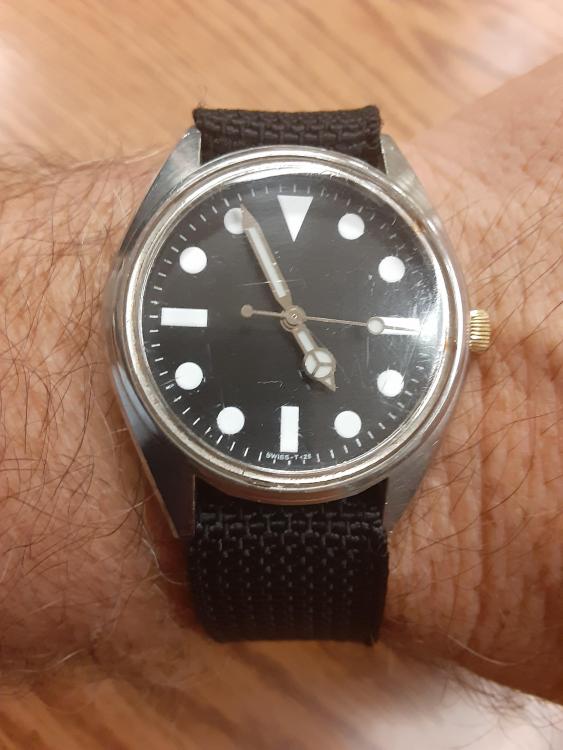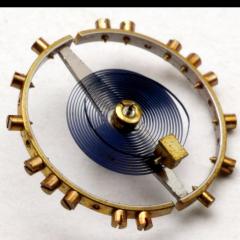Leaderboard
Popular Content
Showing content with the highest reputation on 12/18/19 in all areas
-
Ronsonol lighter fluid is so safe you can clean watch hairsprings in it. It doesn't dissolve shellac, so the pallet stones are save and so are the impulse pins on the balance. You can leave parts in Ronsonol for days, providing you have the parts in jar that has a screw fitting lid. The fluid evaporates very quick.3 points
-
A while back I posted a urika hamazawa..It was really worn past practical repair..If you are familiar with the hamazawa movement ,you know it's quite tall. So I conducted an experiment...Urika case ... dg2813 movement...generic 29mm sterile dial generic hands ...."custom" plastic movement holder ring and bulova water proof crown. It all lines up..works like a charm..something to think about if you have an old non working hamazawa you want to play with.2 points
-
It would date from the mid to late 40's, not convinced by that dial at all, it looks like it has been repainted at some time recently, the only other variants of that model had two tone dials, and do not have Rolex Oyster printed on them just the Tudor name under the Tudor rose.1 point
-
I don't know that there is anything in the Russian watch industry that isn't a copy.1 point
-
That is what I was concerned with.it seems to be a good choice then..while I can't claim to know the brand specifically ,if you are satisfied with the quality it is likely a good choice.1 point
-
In my experience opening a hole much more than one or two jewel sizes (0.10- 0.20mm) runs a real risk of losing the original hole location. It may drift just a hundredth of a millimeter or two, which for a barrel or center wheel might not matter too much, but for smaller wheels with finer teeth and closer pitching it can cause issues. As vinn3 mentions the hole can be elongated too, which requires at the least "drift broaching" back to approximate true center before continuing. I personally wouldn't try to open a hole that was unjeweled up to a size suitable for a jewel with reamers, I would do it in a faceplate. There are numerous techniques for centering, the classical being a long piece of pegwood and more modern using optics. I won't get into the entire process as it's covered in numerous books but the pegwood technique is fairly simple but hard to explain clearly without getting long winded.1 point
-
You need a jeweling tool, the name really says it all. A complete tool has reamers to ream the hole out to 0.01mm smaller than the jewel you want to fit and then has pushers you use in the jeweling tool to fit them. How to correctly use a jeweling tool is a whole other topic though. Main brands are Seitz, Favorite or Bergeon but there are other brands. This is a pretty typical example. https://www.ebay.co.uk/itm/FAVORITE-Delux-Jeweling-Tool-Watchmakers-bench-Tool/223723978922?hash=item3416fd00aa:g:r0gAAOSw50VdqTT9 I have done it before, but on valuable watches its considered bad practice to change the watch, the correct thing would be to bush back with brass is it didn't have a jewel before1 point
-
Many, many topics on the same subject, it's always better to search before asking. Lighter fluid contains wax, perfume, and other contaminants. It is made to burn well, not to clean well. It was recommendable decades ago when no practical alternatives existed. Use instead petroleum ether, which is pure and leaves no residue. It is cheap and available online.1 point
-
1 point
-
A perfectly poised balance wheel is only the most basic step to start positional adjustment. If all you need is a poised balance wheel then stating the number of positions adjusted is irrelevant. Most of the work is done at the hairspring. Introducing poise errors to the balance wheel to counteract errors caused by the hairspring is not an ideal solution because these manipulations would have variable effects at different amplitudes. Such method should only be done to take out small errors after the balance is perfectly poised to begin with and hairspring adjusted to as close as you can.1 point
-
I found this blog to be very helpful in understanding watch adjusting. https://adjustingvintagewatches.com/what-is-watch-adjusting/1 point
-
Oh.. missed that this was a 2809.. the so called Zenith copy. And yes, that's an offset cannon pinion. I have worked on several and while the movement is nice I had a lot of problems with the hands as the hand no tube, just holes which were worn. That would make a nice present. Anilv1 point
-
PS what you have is the only ever chronometer grade mainspring watch ever produced in Russia..it is a fine piece of engineering and it is worthy of your efforts.1 point
-
If it is something like the 2209 there is a pretty large gear at the bottom of that wheel that engages another gear.it is pretty picky about placement. It is possible to install it incorrectly so that it does not mesh. Re install carefully under magnification. That wheel and the second hand shaft ride in jewels in the barrel bridge. On the 2209 I have had the best success by installing the train bridge first. Then installing the barrel bridge without the mainspring to check that nothing binds. When I am happy with the mesh I then install the mainspring..1 point
-
Decent watch deserves decent strap.How heavy is the watch? If the case is on the bulky side it might look too big on a leather strap.before you pay good money for a good strap.buy a cheap one see how it looks...see how you like the proportions. most importantly see how it wears.1 point
-
1 point
-
A lot of this depends upon how serious you are as a beginner? In other words is is a one time cleaning or a lifetime hobby? Then for other ideas do a search of the discussion group as others have asked the same question before.1 point
-
A related question in the US would be why are Swiss watches sometimes marked unadjusted or limited number adjustments versus American pocket watches for instance? That was because of the early days to protect the American watch industry there were tariffs and things like adjustments the number jewels marked on the plates push the cost up. So the watches were all adjusted or regulated they just weren't marked that. The terminology is kind of misleading? The simple answer is they verified that the watch would keep time in various positions and temperatures. Then the other thing that happens with watches that are marked multiposition temperature etc. the quality the watch improves. I'm attaching a PDF it explains what they expect just not how they did it. So regulated of course means you can move the regulator watch keeps time. Ideally on a railroad watch the regulator is in the middle timing screws were adjusted to get the watch to keep time. Adjusted to position means they took time to poise the balance wheel. The more adjustments the more time they spent to get that right. Adjusted the temperature is usually a bimetallic balance wheel that they moved the screws around to find the proper position where the movement of the bimetallic balance wheel would cancel out the effect of temperatures. Hamilton 992b 950 timing.PDF1 point
-
1 point
-
Or you can, for starters, go the manual way and use lighter fluid/naptha (which is what most people recommend, especially for beginner work). Could also use some water and diswashing soap I guess. Perhaps some isopropyl for final rinsing.... ? Careful what you clean and how. The palet fork needs a different approach. Ultrasonic can make the rubis come off.1 point
-
Entire books can be written on the topic. But quick and dirty of it is that the screws closest to the cuts in the rim would be used to adjust for temperature.1 point
-
1 point
-
Hi Andy, well done! Again! Found this: http://www.kanikune.com/catalog/product_info.php?products_id=115 Best regards, Lui1 point
-
Hopefully these 3 pictures will explain the use to you on how they are used to remove and insatll the cylinder plugs show in John's post This is from Archie B Perkins book Antique Watch Restoration Volume 1 which is just 1 of 4 great books from Archie if you have the money spare as they are not cheap.1 point
-
I suppose a picture would help. Before the lever escapement there were other escapement's one of them that was very popular was the cylinder escapement. It is an interesting feature where if you break a pivot off it can be replaced. Then a note regarding proper horological terminology? A lot of this will depend upon when and where you are. There are quite a few parts that will have multiple of names for the exact same part. This leads to irritation and confusion by the material house people when people insist on using names different than what they're used to. So for instance grabbing a copy of Britain's watch and clock makers handbook dictionary and guide refers to the things that go in the cylinder as plugs. Continuing with my amusement on terminology I would agree with Tmuir that his terminology is correct because I've seen references to that. But grabbing a another reference that I would consider more reliable or at least better or perhaps is the book The Illustrated Professional Dictionary of Horology by G A Berner a rather interesting book because It has lots of horological terms and it's in three languages. So in its definition or talking about the cylinder it refers to the things on the end as plugs made of steel. There is an electronic version of the book available at the link below which totally sucks for the definition of what a cylinder escapement is as it's lacking quite a few words missing from the book itself. But apparently the book is available for purchase and yes it's always been expensive if you could find it. https://www.fhs.swiss/eng/dictionary.html1 point








